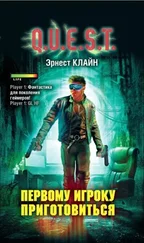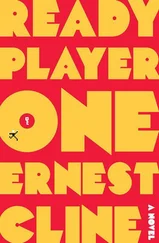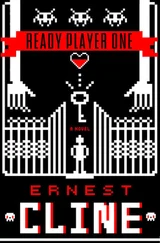I was standing just inside the glass double doors that served as Happytime Pizza’s front entrance. Someone had carefully taped sheets of tinfoil over them, to prevent any sunlight from intruding upon the dark neon cave of the game room. I tried to open the doors, but they were locked, apparently from the outside. I peeled back a corner of the foil to peek outside, only to discover that the entire building appeared to be hovering in a pitch-black void. I smoothed the tinfoil back into place, then turned around and did a slow scan of my surroundings.
Happytime Pizza was divided into two halves, the game room and the dining room. But actually they were both game rooms, because all of the tables in the dining room were sit-down cocktail videogame cabinets.
I took a few steps into the dining room to get a better look, and I could feel the soles of my tennis shoes sticking to the dried soda residue on the checkerboard-pattern linoleum floor with each step I took. There were a couple of NPC pizza chefs back in the kitchen, both tossing dough in the air, and they each waved to me in mid-throw. I waved back, and that was when I noticed my right hand. It wasn’t my right hand at all….
I caught a glimpse of my reflection in the two-way mirror adjacent to the manager’s office. I did an involuntary double take. I was no longer my avatar, Parzival. Now I was Kira Underwood, when she was in her late teens, instantly recognizable from the handful of photographs taken of her during her time in Middletown in the late ’80s. I had her adorable pixie haircut, her giant designer prescription eyeglasses (with clip-on, flip-up mirrored sunglasses), and her trademark acid-washed jean jacket, adorned with countless patches, buttons, and pins. I glanced down and took a quick inventory. I also had Kira’s boobs, and her hips, lips, fingertips—all of it. I even pulled my right sleeve to check the back of my forearm and there it was—Kira’s tiny birthmark. The one that distinctly resembled a map of Iceland.
I didn’t just look like her. I was her.
I turned around and walked back toward the game room. As I entered, Rick Springfield’s “Jessie’s Girl” began to play on the new compact disc–powered jukebox standing in the corner—a jukebox that hadn’t been present in the previous iterations of Happytime Pizza I’d visited. It was my first indication that this one was set in a more recent time period than the others—probably somewhere in the fall or winter of 1988 or the spring of ’89, when Kira Underwood had lived in Middletown.
About two dozen videogames were packed into the game room, with about a dozen NPCs spread among them. They were all teenage boys in late-’80s attire, each one standing at a different game. They all had their backs to me, and they continued to keep them that way as I walked past them.
As I made my way to the back of the game room, I spotted the familiar Defender marquee, with the same handwritten note taped to it that I’d seen on my last visit: Beat the owner’s high score and win a free large pizza! But most of the other games I remembered seeing in the Archaide instance of Happytime Pizza had now been replaced with newer titles. Pac-Man, Galaga, and Dig Dug had been swapped out with Golden Axe, Final Fight—and way at the back, what appeared to be a brand-new Sega Ninja cabinet.
“There it is!” Aech and Shoto shouted. I’d momentarily forgotten that they were monitoring me, and their disembodied voices nearly made me jump out of my skin.
“Thanks, amigos,” I said. “But I saw it too. You’re watching my POV, remember?”
“Right, sorry,” I heard Aech say. “We’re both just a little anxious is all!”
“I can relate,” I said, walking over to the Sega Ninja cabinet to size up my opponent. Its illuminated marquee had the word NINJA printed on it in large stylized yellow and orange letters, with the smaller SEGA logo underneath it. But on the monitor, the title appeared as SEGA NINJA.
The game’s attract mode cycled between its high-score list, short clips of automated gameplay on different levels, and a brief-but-beautiful piece of 8-bit animation, which showed Princess Kurumi being carried across a bamboo bridge on a palanquin by two masked ninja thugs. In the distance, beyond fields of red roses and forests of cherry-blossom trees, over a broad blue river, you could see the purple-roofed Kanten Castle, perched high in the clouds, atop a gorgeously rendered snowcapped mountain range that filled the distant horizon. Suddenly, Kurumi leaped out of the palanquin, wearing a fancy red Queen Amidala gown. Then, in a puff of ninja smoke, she changed into more battle-ready attire—a red silk kunoichi —and chased after her former captors, presumably to murder them just offscreen.
I took a quarter out of my inventory and dropped it into the left coin slot. Then I removed my clip-on mirror shades and hung them on top of the game’s marquee. This allowed me to use their lenses as rearview mirrors, providing a wide-angle view of everything behind me. This was a trick I’d learned from Art3mis, during one of our early online pseudo-dates on Archaide. She liked to wear mirror shades back then too. When she was still deep in her Molly Millions phase.
I glanced at the game’s colorful instruction card, located beneath the Plexiglas bezel that encircled the monitor:
Regain the KANTEN CASTLE from the evil hands of the traitor, ZAEMON!!
The NINJA group called PUMA is obstructing princess KURUMI’S way!!
Defeat their leader, NINNIKU and proceed to the castle!!
The instructions featured cartoon renderings of Kurumi, the gun-wielding big boss Zaemon, and his blond-haired underling Ninniku, along with a helpful diagram showing what the game’s three control buttons did. One turned the princess invisible for a few seconds, making her immune to attacks. The second made her throw a knife in the direction she was facing at the moment, and the third made her throw a knife in the forward direction only, toward the top of the screen, allowing the player to fire while moving in another direction.
“Umm, Wade? Please tell me you’re not reading the instructions right now,” Shoto said, sounding deeply amused.
“You’ve never played Ninja Princess before, have you?” Aech asked.
I sighed. It sounded like Kira Underwood was the one sighing.
“Yes, I have,” I replied. “But only once or twice. Six or seven years ago.”
“Great,” Aech muttered. “This should go well.”
“Relax,” Shoto said. “Sega Ninja is standard run-and-gun fun. I’ll walk you through each of the sixteen levels. Some of them are pretty difficult to clear. But you can handle it.”
“ Arigato, Shoto,” I said, as I slapped the Player One button. “Here goes nothing.”
I rested my right hand on the joystick and my left over the three control buttons.
The game began with a brief animation, showing Princess Kurumi changing out of a fancy silk kimono into her red kunoichi garb, as the poorly translated message PRINCESS’ES ADVENTURE STARTS is typed out above her, one letter at a time. Then a familiar warning appeared in the center of the screen: PLAYER 1 START, followed by a rectangular map of the kingdom showing my current position at the bottom, and the route I would have to follow to reach Kanten Castle.
Then the first level or “step” of the game appeared—a sprawling green meadow, covered in patches of colorful flowers and strewn with the occasional tree or giant boulder. My tiny pixelated avatar appeared at the bottom center of the screen, and in that instant I was back in the zone. I wasn’t Kira Morrow, or Parzival, or Wade Watts. The controls became an extension of myself, and I became the vengeful Princess Kurumi, clad in blood-red silk and armed with an infinite supply of throwing knives, intent on reclaiming my stolen kingdom at any cost.
Читать дальше
![Эрнест Клайн Ready Player Two [calibre] обложка книги](/books/438636/ernest-klajn-ready-player-two-calibre-cover.webp)







![Эрнест Клайн - Второму игроку приготовиться [ЛП]](/books/436170/ernest-klajn-vtoromu-igroku-prigotovitsya-lp-thumb.webp)



